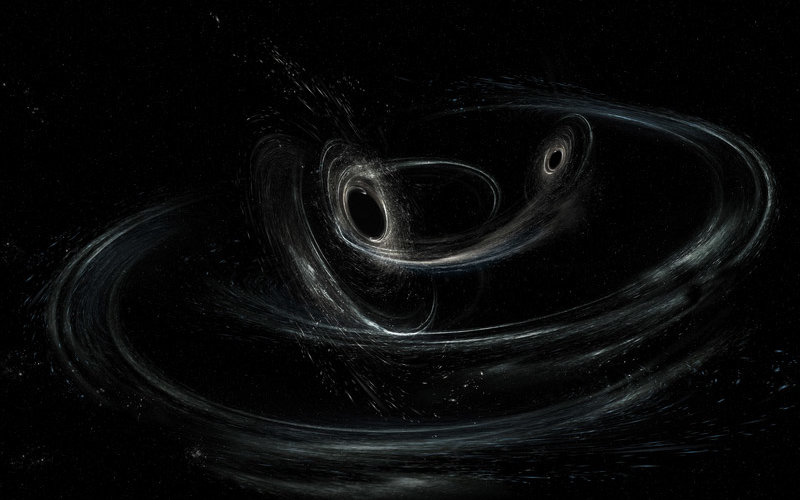
Cal State Fullerton physics faculty and student researchers once again share in the detection of gravitational waves — for the third time. The Laser Interferometer Gravitational-wave Observatory, known as LIGO, has made a third detection of gravitational waves from two black holes colliding to form a larger black hole.
This gravitational-wave detection passed through Earth on Jan. 4, 2017 — from roughly three billion light years away — and is described in a new scientific journal article published today (June 1) in Physical Review Letters.
The waves were generated when black holes, 30 and 20 times the mass of the sun, merged to form a larger black hole nearly 50 times the mass of the sun, explained Joshua Smith, associate professor of physics and Dan Black Director of Gravitational Wave Physics and Astronomy.
Smith, along with physics faculty members Geoffrey Lovelace and Jocelyn Read, computational specialist Joe Areeda, and physics graduate students Adrian Avila-Alvarez and Torrey Cullen — all from CSUF’s Gravitational-Wave Physics and Astronomy Center — are authors on the paper. CSUF alumni, and now doctoral students, Thomas Abbott at Louisiana State University, and Fabian Magaña-Sandoval, Erik Muniz and Daniel Vander-Hyde, all at Syracuse University, also are authors.
This third discovery of merging black holes helps scientists to map out a population of black holes: to determine how massive they are, whether they are spinning, where they are in the universe and how often they merge into larger black holes, said Smith. His work helped LIGO establish that this latest gravitational-wave signal was not caused by terrestrial disturbances.
While the latest merger of massive black holes is similar to the first gravitational-wave detection in 2015, this new signal traveled through the universe the farthest distance yet, with the black holes located about 3 billion light years away before it reached Earth, noted Read, assistant professor of physics.
“It’s amazing that we can see so far back toward the early universe. Seeing more of these massive black-hole mergers helps us learn how stars have lived and died throughout the universe’s history,” said Read, who studies the violent collision of neutron stars to produce gravitational waves. Read and Cullen, who begins doctoral studies at Louisiana State University this fall, are exploring how matter behaves at such extreme densities. Read also looks forward to LIGO’s anticipated detection of gravitational waves from merging neutron stars.
This newest observation also provides clues about the directions in which the black holes are spinning, added Read. As pairs of black holes spiral around each other, they also spin on their own axes — like a pair of ice skaters spinning individually, while also circling around each other.
“Knowing the direction of the black hole spin can help us to understand how pairs of merging black holes form and whether they formed from a spinning cloud of matter or were dynamically captured by gravity,” added Lovelace, assistant professor of physics.
Lovelace and undergraduates Nick Demos and Alyssa Garcia, both recent physics graduates, computed gravitational waves from merging black holes and compared them with LIGO’s astronomical observation. In the fall, both are entering doctoral programs, with Demos off to MIT and Garcia to Brandeis University. Lovelace also was part of the team that developed a key visual graph in the scientific article reporting the discovery, which represents the observations and compares them with Einstein’s theory of general relativity.
Video: Cal State Fullerton’s Geoffrey Lovelace, assistant professor of physics, and his students, Class of 2017 graduates Nick Demos and Alyssa Garcia, worked with the Simulating eXtreme Spacetimes Collaboration to create this video illustrating the detection of the third gravitational wave, called GW170104. The video shows the warped space-time near the merging black holes. The colored bands are gravitational wave peaks and troughs, with the colors getting brighter as the wave amplitude increases, while the center of the video indicates the strong space-time warping near the black holes. Video Courtesy of SXS Collaboration.
“The most exciting thing for me is how loud and clear this latest gravitational wave was,” Lovelace said. “Loud gravitational waves best reveal Einstein’s theory of general relativity in action under the most extreme conditions in the universe — and now we know that these waves aren’t rare.
“The loudness allows us to see the waves more clearly above the noise in the LIGO detectors. That allows us to more carefully check Einstein’s theory and other theories against the data.”
This recent detection occurred during LIGO’s current observing run, which began Nov. 30, 2016, and continues through the summer. LIGO is an international collaboration with more than 1,000 members around the globe, including CSUF. LIGO’s observations are carried out by twin detectors in Hanford, Washington, and Livingston, Louisiana, and are operated by Caltech and MIT.
“The LIGO observatories have given us an incredible new way to measure the movement and properties of black holes — information that is completely invisible through light,” Smith said.